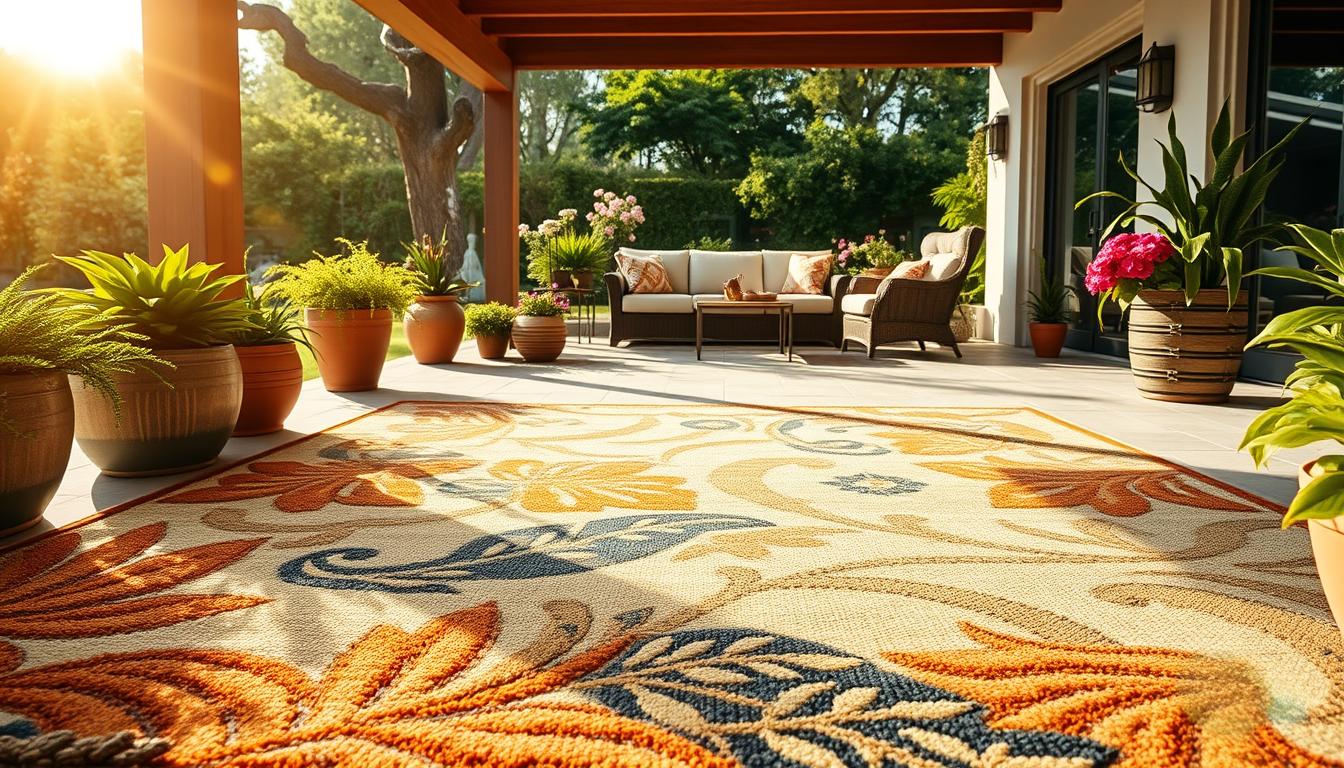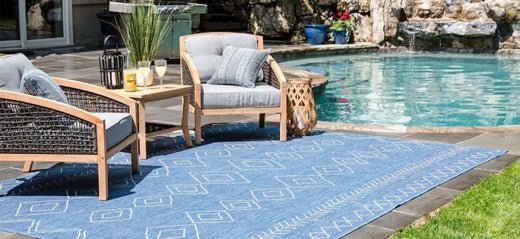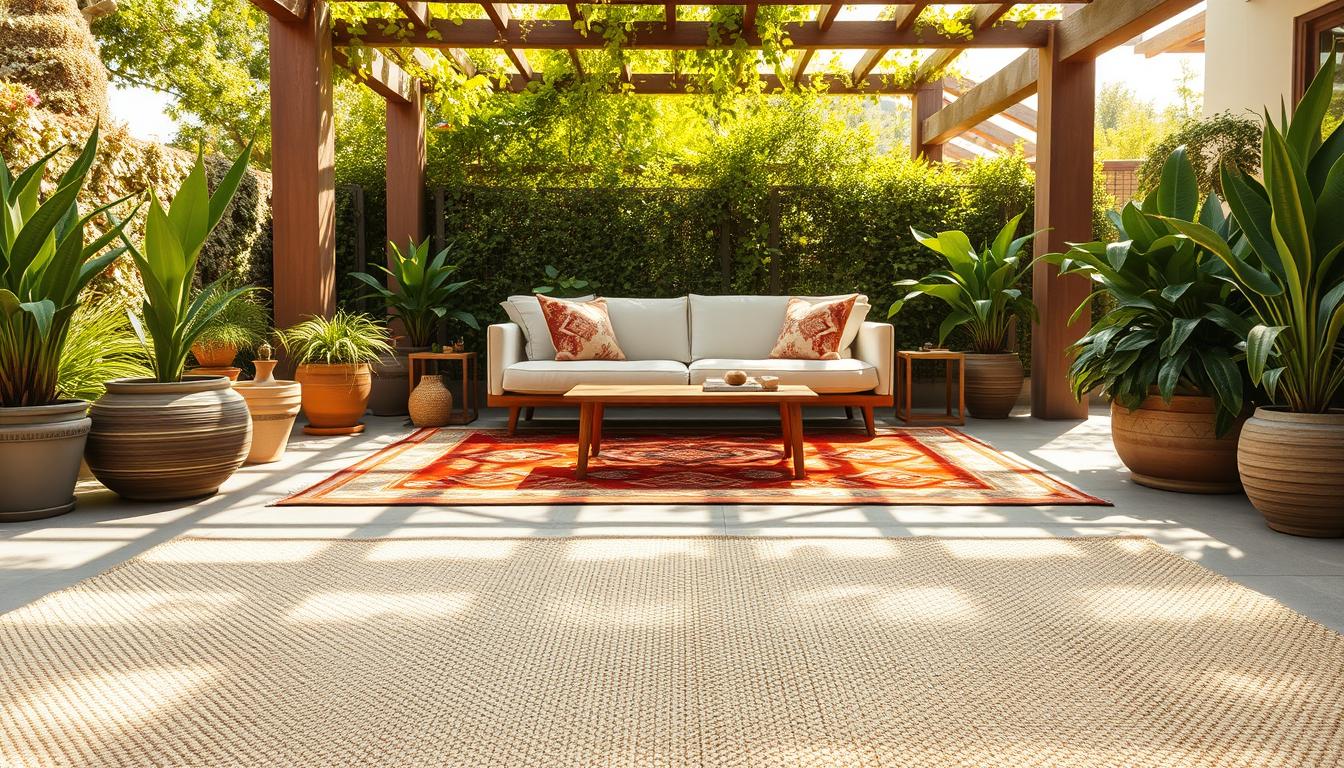
7 Best Benefits of Using Outdoor Rugs
Could your patio feel as cozy as your living room? Most homeowners overlook one simple upgrade that bridges indoor comfort with exterior durability: weather-resistant floor coverings designed for year-round use. Unlike standard indoor mats, these specialized pieces blend practicality with design to redefine how you experience open-air settings.

Built to endure rain, UV rays, and heavy foot traffic, these durable solutions protect surfaces while adding warmth. They’re not just decorative—thick weaves prevent slips, while fade-resistant materials maintain vibrant colors season after season. From sleek modern patterns to earthy durable jute options, there’s a style for every porch, deck, or balcony.
Imagine hosting summer gatherings where guests linger comfortably under string lights. Or enjoying morning coffee on a surface that feels inviting, not cold. That’s the magic of merging function with ambiance—turning bare floors into extensions of your home’s personality.
Key Takeaways
- Weather-resistant construction outperforms indoor alternatives
- Versatile designs complement any patio or deck aesthetic
- Protects flooring from scratches and weather damage
- Adds slip resistance for safer surfaces
- Saves money by avoiding frequent replacements
- Available in materials from polypropylene to natural fibers
- Instantly transforms bland areas into welcoming retreats
Understanding What is Outdoor Rug
Ever wondered how to extend your home’s comfort beyond the back door? Specialized floor coverings bridge that gap, merging plush textures with all-season resilience. Designed for patios, decks, and balconies, these pieces handle rain, UV rays, and foot traffic without losing their charm.
Defining Weather-Resistant Floor Coverings
Unlike standard indoor options, these solutions use synthetic plastics or treated natural fibers. Polypropylene and vinyl resist mold, while UV-protected dyes prevent fading. "They’re not just durable—they’re style chameleons," notes a landscape designer. Neutral geometric patterns or earthy jute weaves adapt to modern farmhouse lounges or coastal-themed verandas.
Elevating Exterior Living Areas
Transform concrete slabs into cozy extensions of your living room. A well-chosen piece anchors seating arrangements, creating zones for BBQs or sunset cocktails. Maintenance? Shake off debris, rinse with a hose, and air-dry. No expensive cleaners needed.
From poolside safety to defining dining spaces, these textiles prove practicality doesn’t sacrifice beauty. They’re the silent heroes of alfresco design—enduring storms by day and hosting memories by night.
Choosing the Perfect Outdoor Rug for Your Outdoor Space
A well-chosen floor covering turns chaotic spaces into curated exterior rooms. Getting the proportions right ensures harmony between your furniture layout and available area. Let’s break down the essentials for creating a polished look that withstands weather and wear.

Assessing Size and Layout for Optimal Fit
Start by measuring your deck or patio. Leave 18 inches of bare flooring around edges for walking space and visual balance. For seating areas, follow the two-leg rule: position pieces so at least two legs rest on the textile. This anchors the arrangement without overcrowding.
| Size | Best Use | Furniture Capacity |
|---|---|---|
| 5x7 ft | Bistro sets | 2 chairs + small table |
| 8x10 ft | L-shaped sectionals | Sofa + 3 seats |
| 9x12 ft | Dining areas | 6-chair table + pullout space |
Selecting the Right Materials and Styles
Sun-drenched spaces need UV-resistant polypropylene, while damp zones require quick-dry vinyl. For high-traffic areas near sectional seating arrangements, choose tightly woven patterns that hide dirt. Neutral geometrics suit modern themes, while floral motifs enhance cottage aesthetics.
Remember: Your textile should complement existing cushions and planters. A charcoal rug grounds earthy tones, while navy stripes echo coastal vibes. Balance practicality with personality for spaces that feel intentional yet inviting.
Outdoor Rug Materials and Durability Options
Your choice of textile composition determines whether your patio centerpiece survives one summer or five. Let’s dissect the battle between engineered synthetic fibers and earthy plant fibers—each offering distinct advantages for different environments.
Synthetic Fibers: Polypropylene, Nylon, and Polyester
Polypropylene reigns supreme for all-weather performance. This plastic-based material laughs at rainstorms and resists fading better than most options. Need proof? Spill red wine on it—stains rinse off with a garden hose.
Nylon handles heavy foot traffic near pools or grills but stays cooler in shaded areas. Polyester offers vibrant colors that resist UV damage, though it’s less durable for active zones. All three share mold-resistant properties, making them ideal for humid climates.
Natural Plant Fibers: Jute, Sisal, and Cotton
Organic textures bring warmth to covered porches but demand careful placement. Jute’s golden hues complement wool blends in dry environments, while tightly woven cotton works under pergolas. Avoid using these near sprinklers—they absorb moisture like sponges.
Weather Resistance and UV Protection Features
Top-tier synthetics include UV inhibitors that block color fading. Look for treatments that repel water while allowing airflow—key for preventing mildew under damp furniture. For sunny decks, prioritize materials with fade warranties exceeding three years.
Remember: No material is bulletproof. Rotate rugs seasonally to ensure even wear, and always check manufacturer guidelines for extreme weather care.
Design, Color, and Pattern Inspirations for Your Patio
Patio design isn’t just about furniture—it’s about the foundation beneath your feet. The right floor covering acts as both anchor and accent, merging practicality with visual storytelling. From bold geometric statements to earthy textures, your choice sets the tone for every gathering.

Innovative Design Styles to Complement Outdoor Furniture
Bohemian textiles bring carefree energy to casual seating areas. Think tasseled edges and faded motifs that pair perfectly with wicker chairs. For desert-inspired charm, Southwestern patterns feature terra-cotta hues and tribal zigzags—ideal for firepit zones.
Prefer drama? Leopard prints or floral medleys transform bland decks into conversation starters. Aztec geometrics offer structured flair, balancing modern sectionals with intricate symmetry. Each style serves as a backdrop that enhances—never overpowers—your existing setup.
Coordinating Colors and Patterns for a Cohesive Look
Black-and-white stripes create crisp contrast against wooden tables, while navy hues mirror coastal skies. For pops of energy, turquoise or coral textiles energize neutral spaces. Striped designs work like magic, blending multiple shades without clashing.
Geometric shapes add sophistication to contemporary settings. Pair hexagonal motifs with metal accents or circular patterns with curved benches. Remember: cohesive doesn’t mean matchy-matchy. Let your floor piece harmonize with cushions and planters through shared tones or complementary contrasts.
Outdoor Rug Maintenance and Care Tips
Proper care transforms seasonal décor into year-round assets. Whether battling summer spills or prepping for winter storage, smart strategies keep your textiles vibrant and functional through changing conditions.
Effective Cleaning Strategies and Spill Management
Vacuum weekly to remove grit that grinds fibers. For sticky messes, proven cleaning methods recommend hosing down affected areas within 15 minutes. Blot—don’t scrub—to prevent stains from setting.
Mold thrives in damp corners. Lift edges periodically to check for mildew, especially under tables. For stubborn spots, mix equal parts vinegar and water. This cuts through grime without harsh chemicals.
Seasonal Storage, Rug Pads, and Longevity Solutions
Roll—never fold—your floor coverings before winter storage. Use breathable fabric wraps instead of plastic to prevent moisture buildup. A quality pad adds cushioning while creating airflow channels beneath.
High-traffic zones like entryways benefit from these durable textiles. Their moisture resistance makes them ideal for basements or playrooms. Specialized cleaning techniques extend their lifespan when used indoors.
Rotate pieces every three months to ensure even sun exposure. Store extras under beds or in climate-controlled closets during off-seasons. With consistent care, your investment stays fresh through countless gatherings.
Conclusion
Ready to blur the line between indoor comfort and alfresco charm? Weather-resistant floor coverings offer more than surface appeal—they’re transformative elements for decks, patios, and balconies. These textiles create welcoming zones where bare feet meet cozy textures, while bold patterns inject personality into bland concrete or wood.
Though designed for harsh conditions, even durable materials need smart care. Regular hosing and seasonal rotation combat sun damage, extending their lifespan beyond typical disposable décor. Rotate styles annually if you crave fresh looks without replacing entire setups.
From synthetic polypropylene to organic jute blends, today’s options balance practicality with visual impact. Neutral geometrics suit modern spaces, while vibrant stripes energize neutral furniture arrangements. Your selection should mirror both climate needs and design aspirations.
With proper maintenance habits and intentional styling, these versatile pieces become permanent fixtures in your exterior living areas. They’re not just floor protectors—they’re the foundation for memories made under open skies. Now’s the time to choose pieces that reflect your home’s character while standing up to nature’s tests.
FAQ
Which materials hold up best in high-traffic or wet climates?
Synthetic fibers like polypropylene and nylon excel in durability for busy spaces. These water-resistant options resist fading, mold, and mildew, making them ideal for poolside areas or rainy regions. Polyester blends offer added UV protection for sun-drenched patios.
How can I protect my rug from harsh weather or UV rays?
Look for UV-resistant treatments and tightly woven fabrics that block sun damage. For rainy climates, choose quick-drying materials with mold-inhibiting properties. Brands like Courtyard Luxury Vinyl or Trellis Weave Polypropylene include built-in weatherproof layers.
What’s the easiest way to clean spills or mud stains?
Blot liquids immediately and hose down synthetic rugs for deep cleaning. Use mild soap with a soft brush on stubborn spots. Avoid harsh chemicals, especially with natural fibers like sisal, which may require gentle spot treatment.
Do natural fiber rugs work in humid or rainy environments?
Jute and sisal absorb moisture, leading to mold in damp climates. For humid areas, opt for synthetic alternatives or treat natural fibers with waterproof sprays. Cotton blends with acrylic coatings offer a breathable yet water-repellent solution.
How do I secure a rug on a windy balcony or deck?
Rug pads with gripper backing prevent slipping and shifting. For loose weaves, use outdoor-safe adhesive tapes or weighted furniture to anchor corners. Woven polypropylene styles with heavier builds stay put in breezy spots.
Can I leave my rug outside year-round in snowy regions?
Even weatherproof rugs benefit from winter storage to prevent ice damage. Shake off debris, roll tightly, and store in a dry place. For all-season use, consider frost-resistant PVC mats designed for extreme cold.









